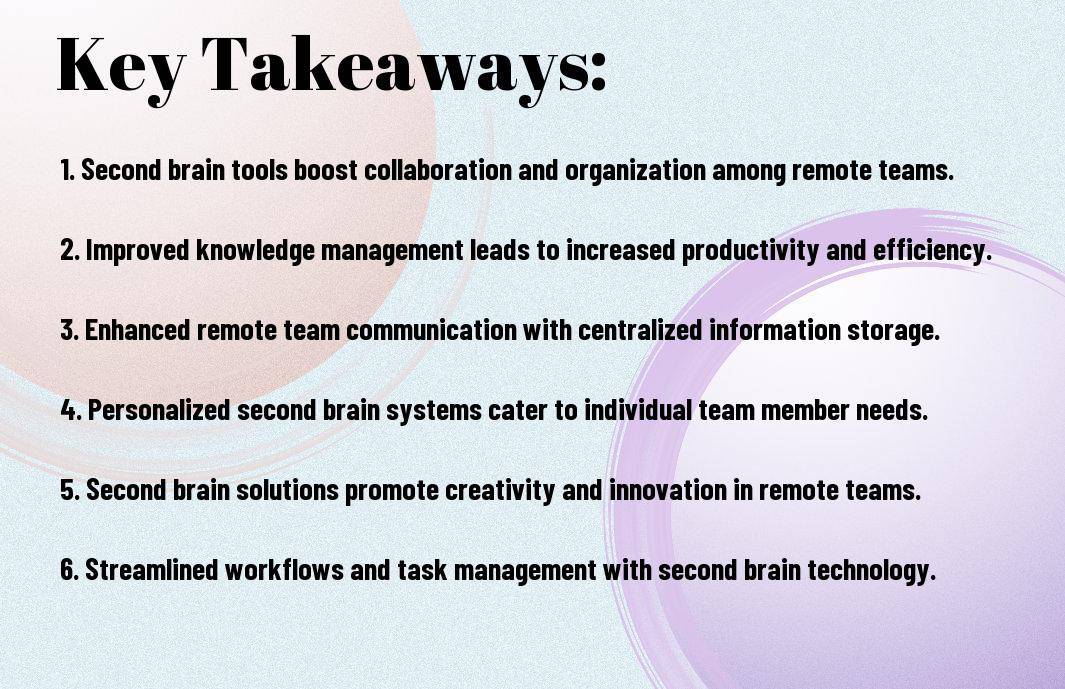
Newsletter Subscribe
Enter your email address below and subscribe to our newsletter

Enter your email address below and subscribe to our newsletter

Remote team productivity! It’s no secret that remote work is becoming increasingly popular in today’s world. With this shift, companies are seeking innovative ways to boost efficiency and collaboration among their teams. One powerful solution that is gaining traction is the concept of a Second Brain. In this blog post, we will explore how implementing Second Brain solutions can enhance remote team productivity and improve overall workflow.


There’s a term that has been gaining popularity in the productivity world – the Second Brain. But what exactly does it mean, and how can it benefit remote teams? Let’s examine into the concept to understand its potential in enhancing remote team productivity.
For remote teams looking to boost their efficiency and creativity, the Second Brain acts as an extension of the human mind. It’s a digital system or platform that helps individuals capture, organize, and retrieve information effectively. Think of it as an external, virtual brain that supplements your memory and cognitive abilities.
The Second Brain comprises various tools and methods to manage information better. These include note-taking apps, cloud storage systems, task managers, and knowledge databases. By utilizing these tools strategically, remote teams can streamline their workflows, collaborate efficiently, and foster innovation.
Components like Evernote, Notion, or Roam Research are popular choices for creating a Second Brain. They enable users to store diverse types of content, link ideas, and access information across devices seamlessly. Having a well-organized Second Brain can lead to improved decision-making, greater focus, and enhanced remote team performance.
Not only has the concept of a second brain revolutionized individual productivity, but it also has a remarkable impact on remote team productivity. According to the 10 Best Second Brain Apps for Note-Taking in 2024, leveraging second brain solutions can significantly enhance collaboration, knowledge sharing, and information management within remote teams.
Streamlined information management is a crucial aspect of remote team productivity. By utilizing second brain solutions, team members can efficiently organize and access crucial information, notes, and resources. This streamlined approach eliminates the clutter and confusion often associated with remote work, allowing team members to focus on tasks at hand without wasting time searching for vital data.
An enhanced collaboration and communication are pivotal benefits of integrating a second brain into remote team workflows. With a centralized repository for shared ideas, documents, and insights, team members can collaborate seamlessly regardless of physical location. This fosters a more connected and productive team dynamic, where information flows freely, ideas are exchanged effortlessly, and projects progress efficiently.
Communication is the lifeline of remote teams, and a second brain solution can significantly improve this aspect by facilitating real-time collaboration and feedback. Whether it’s sharing meeting notes, brainstorming ideas, or providing project updates, a well-organized second brain ensures that communication channels remain open and transparent, ultimately boosting team productivity and cohesion.
One key factor in implementing Second Brain solutions in remote teams is choosing the right tools to facilitate knowledge management and collaboration. There are a variety of tools available, from note-taking apps like Evernote and Notion to project management platforms like Trello and Asana. It’s important to consider the specific needs and preferences of your team when selecting a tool that suits your workflow.
One challenge remote teams face is integrating new software or processes into their daily workflows. To overcome this, it’s crucial to gradually introduce the Second Brain solution and provide adequate training and support. Encouraging team members to experiment with the tool and share their experiences can help foster adoption and create a culture of continuous learning and improvement.
Right from the beginning, emphasize the importance of incorporating the Second Brain into daily routines and workflows to get the most out of its potential benefits. Consistency is key in building a strong foundation for knowledge sharing and collaboration among remote team members.
All remote teams can benefit from leveraging a Second Brain solution to enhance productivity and collaboration. Training team members on how to effectively use this tool is crucial for maximizing its potential. By providing comprehensive training, teams can unlock the full benefits of storing, organizing, and retrieving information efficiently.
Training sessions should cover the basics of setting up and customizing the Second Brain solution to suit each team member’s workflow. Encouraging consistent usage and demonstrating how to integrate the tool seamlessly into daily tasks can significantly boost team productivity and streamline communication. Emphasizing the importance of tagging, linking, and categorizing information will help team members access critical data effortlessly, fostering a culture of knowledge sharing and collaboration.
Practices such as regular check-ins and continued support can aid in overcoming common challenges that arise when implementing a new productivity tool like a Second Brain. Team members may face resistance to change or struggle with adopting new digital habits. By providing ongoing guidance and resources, teams can navigate these hurdles and fully embrace the benefits of a Second Brain solution.
Many remote teams are adopting second brain solutions to enhance productivity and efficiency. However, it is vital to measure the success of implementing a second brain system to ensure it is truly benefitting the team. By monitoring specific productivity metrics and gathering feedback, teams can assess the impact of their second brain implementation.
One key way to measure the success of a second brain implementation is by monitoring productivity metrics. These metrics can include tasks completed per week, reduction in time taken to find information, increase in project completion rates, and overall team collaboration. By tracking these metrics, teams can evaluate the effectiveness of their second brain system in improving productivity.
One important aspect of measuring the success of second brain implementation is gathering feedback from team members. Feedback can provide valuable insights into how team members are utilizing the second brain system, what challenges they may be facing, and what improvements can be made. By continually seeking feedback and making necessary adjustments, teams can ensure that their second brain solution is optimized for maximum productivity.
Brainstorming regular feedback sessions and encouraging open communication within the team can help address any issues or concerns that may arise. By fostering a culture of continual improvement, teams can constantly fine-tune their second brain implementation for better results.

Trends in the digital work environment indicate a rapid shift towards remote and flexible work arrangements. With the rise of digital nomads and distributed teams, the need for effective collaboration and knowledge management tools has never been greater. Second Brain solutions are becoming necessary for professionals to organize information, generate ideas, and enhance productivity in this new era of work.
Digital advancements are paving the way for exciting developments in second brain technology. Artificial intelligence and machine learning algorithms are being integrated into these tools to provide personalized recommendations, automate organization processes, and offer predictive insights based on user behavior. The future holds immense potential for second brain solutions to revolutionize how we capture, store, and access information.
This not only streamlines workflows but also enables individuals to focus on high-value tasks rather than getting lost in information overload. The integration of advanced technologies will further empower users to unlock their creativity, make informed decisions, and achieve higher levels of efficiency and innovation in their work.
So, with the rise of remote work, it has become more crucial than ever to find innovative solutions to enhance team productivity. Second Brain solutions offer a promising way to organize information, collaborate effectively, and streamline workflows for remote teams. By creating a centralized digital brain, team members can easily access and contribute to valuable knowledge, leading to improved productivity and efficiency.
By adopting Second Brain solutions, remote teams can foster creativity, communication, and collaboration, ultimately leading to better outcomes and increased success. With a well-structured system in place to capture, connect, and cultivate knowledge, teams can work more cohesively and efficiently, even when physically separated. So, consider implementing Second Brain solutions to empower your remote team and take productivity to the next level.
A: A Second Brain solution is a system or method for capturing, organizing, and accessing information to enhance productivity and creativity.
A: Second Brain solutions can help remote teams by providing a centralized hub for storing and accessing knowledge, facilitating collaboration, and improving workflow efficiency.
A: Popular Second Brain tools for remote teams include Notion, Evernote, Roam Research, and Obsidian.
A: By allowing team members to easily share and access information, Second Brain solutions can foster better communication, collaboration, and knowledge-sharing among remote team members.
A: Key features to look for in a Second Brain solution for remote teams include cross-device synchronization, powerful search capabilities, customizable organization structures, and integrations with other productivity tools.
A: Remote teams can ensure data security when using a Second Brain solution by implementing strong password practices, enabling two-factor authentication, and carefully managing access permissions for sensitive information.
A: Remote teams can get started with implementing a Second Brain solution by conducting research to find the right tool for their needs, setting up a shared workspace for collaboration, and providing training and support for team members to effectively use the system.